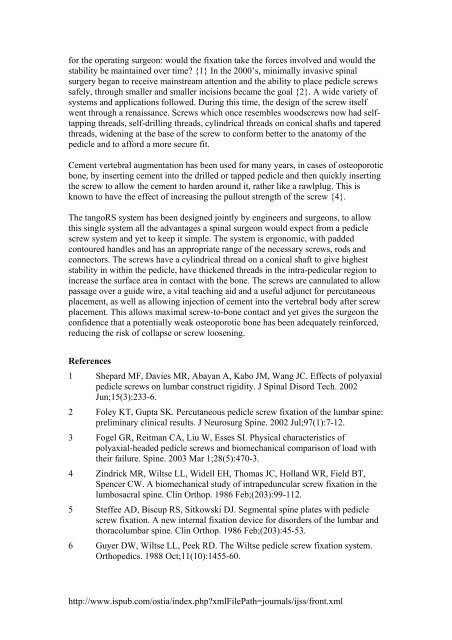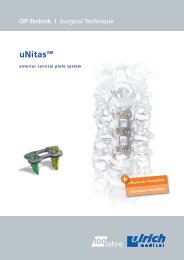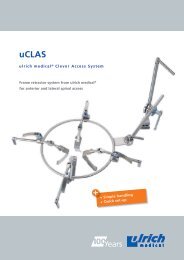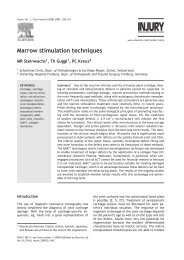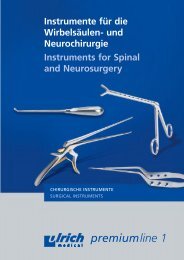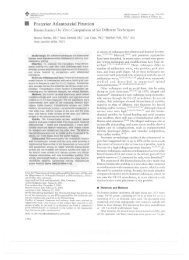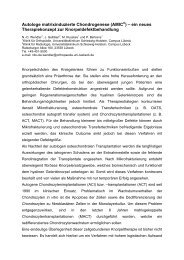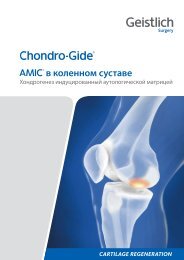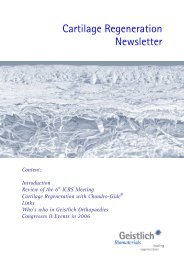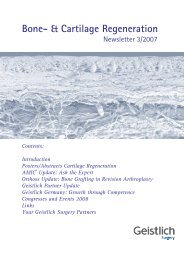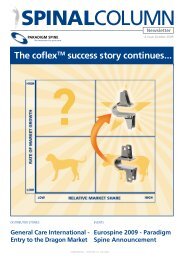Preliminary experience with the tangoRS: polyaxial, percutaneous ...
Preliminary experience with the tangoRS: polyaxial, percutaneous ...
Preliminary experience with the tangoRS: polyaxial, percutaneous ...
Create successful ePaper yourself
Turn your PDF publications into a flip-book with our unique Google optimized e-Paper software.
for <strong>the</strong> operating surgeon: would <strong>the</strong> fixation take <strong>the</strong> forces involved and would <strong>the</strong><br />
stability be maintained over time? {1} In <strong>the</strong> 2000’s, minimally invasive spinal<br />
surgery began to receive mainstream attention and <strong>the</strong> ability to place pedicle screws<br />
safely, through smaller and smaller incisions became <strong>the</strong> goal {2}. A wide variety of<br />
systems and applications followed. During this time, <strong>the</strong> design of <strong>the</strong> screw itself<br />
went through a renaissance. Screws which once resembles woodscrews now had selftapping<br />
threads, self-drilling threads, cylindrical threads on conical shafts and tapered<br />
threads, widening at <strong>the</strong> base of <strong>the</strong> screw to conform better to <strong>the</strong> anatomy of <strong>the</strong><br />
pedicle and to afford a more secure fit.<br />
Cement vertebral augmentation has been used for many years, in cases of osteoporotic<br />
bone, by inserting cement into <strong>the</strong> drilled or tapped pedicle and <strong>the</strong>n quickly inserting<br />
<strong>the</strong> screw to allow <strong>the</strong> cement to harden around it, ra<strong>the</strong>r like a rawlplug. This is<br />
known to have <strong>the</strong> effect of increasing <strong>the</strong> pullout strength of <strong>the</strong> screw {4}.<br />
The <strong>tangoRS</strong> system has been designed jointly by engineers and surgeons, to allow<br />
this single system all <strong>the</strong> advantages a spinal surgeon would expect from a pedicle<br />
screw system and yet to keep it simple. The system is ergonomic, <strong>with</strong> padded<br />
contoured handles and has an appropriate range of <strong>the</strong> necessary screws, rods and<br />
connectors. The screws have a cylindrical thread on a conical shaft to give highest<br />
stability in <strong>with</strong>in <strong>the</strong> pedicle, have thickened threads in <strong>the</strong> intra-pedicular region to<br />
increase <strong>the</strong> surface area in contact <strong>with</strong> <strong>the</strong> bone. The screws are cannulated to allow<br />
passage over a guide wire, a vital teaching aid and a useful adjunct for <strong>percutaneous</strong><br />
placement, as well as allowing injection of cement into <strong>the</strong> vertebral body after screw<br />
placement. This allows maximal screw-to-bone contact and yet gives <strong>the</strong> surgeon <strong>the</strong><br />
confidence that a potentially weak osteoporotic bone has been adequately reinforced,<br />
reducing <strong>the</strong> risk of collapse or screw loosening.<br />
References<br />
1 Shepard MF, Davies MR, Abayan A, Kabo JM, Wang JC. Effects of <strong>polyaxial</strong><br />
pedicle screws on lumbar construct rigidity. J Spinal Disord Tech. 2002<br />
Jun;15(3):233-6.<br />
2 Foley KT, Gupta SK. Percutaneous pedicle screw fixation of <strong>the</strong> lumbar spine:<br />
preliminary clinical results. J Neurosurg Spine. 2002 Jul;97(1):7-12.<br />
3 Fogel GR, Reitman CA, Liu W, Esses SI. Physical characteristics of<br />
<strong>polyaxial</strong>-headed pedicle screws and biomechanical comparison of load <strong>with</strong><br />
<strong>the</strong>ir failure. Spine. 2003 Mar 1;28(5):470-3.<br />
4 Zindrick MR, Wiltse LL, Widell EH, Thomas JC, Holland WR, Field BT,<br />
Spencer CW. A biomechanical study of intrapeduncular screw fixation in <strong>the</strong><br />
lumbosacral spine. Clin Orthop. 1986 Feb;(203):99-112.<br />
5 Steffee AD, Biscup RS, Sitkowski DJ. Segmental spine plates <strong>with</strong> pedicle<br />
screw fixation. A new internal fixation device for disorders of <strong>the</strong> lumbar and<br />
thoracolumbar spine. Clin Orthop. 1986 Feb;(203):45-53.<br />
6 Guyer DW, Wiltse LL, Peek RD. The Wiltse pedicle screw fixation system.<br />
Orthopedics. 1988 Oct;11(10):1455-60.<br />
http://www.ispub.com/ostia/index.php?xmlFilePath=journals/ijss/front.xml


